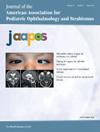Etiologies underlying pediatric papilledema at a tertiary care children’s hospital
IF 1.2
4区 医学
Q3 OPHTHALMOLOGY
引用次数: 0
Abstract
Background
Pediatric papilledema is a common reason for ophthalmology evaluation in high acuity emergency department and inpatient settings. This study describes the frequency of consultation, causative diagnoses, and presenting characteristics of papilledema at a tertiary care children’s hospital.
Methods
All consecutive patients seen in pediatric ophthalmology consultation or diagnosed with papilledema at a large children’s hospital between January 1, 2021, and August 18, 2023, were retrospectively reviewed. Patients with papilledema (disk edema from elevated intracranial pressure) were identified and included in the analysis. Clinical characteristics of their presentations and the diagnoses underlying their elevated intracranial pressures were obtained. Age stratification into three groups for additional analysis was performed.
Results
A total of 71 patients were identified with papilledema. Mean patient age was 13 ± 5.2 years (range, 0-20 years), and 68% of patients were girls. The overall rate of papilledema diagnosis among all unique patient consultations was 3.7%. Papilledema was caused by idiopathic intracranial hypertension (IIH) in 36 cases (51%), and 35 cases (49%) were due to secondary causes of IHH with serious vision- and life-threatening implications. IIH was most common in children >12 years of age, comprising 60% of papilledema cases in the age group.
Conclusions
Pediatric papilledema is associated with a wide range of extremely serious underlying conditions that require a comprehensive, multidisciplinary evaluation in an emergency setting.
在三级保健儿童医院的儿童乳头水肿的病因。
背景:儿童乳头水肿是高急诊科和住院环境中眼科评估的常见原因。本研究描述了咨询的频率,病因诊断,并在三级保健儿童医院乳头水肿的表现特点。方法:回顾性分析2021年1月1日至2023年8月18日在一家大型儿童医院连续就诊或诊断为乳头状水肿的儿童眼科患者。有乳头水肿(颅内压升高引起的椎间盘水肿)的患者被确定并纳入分析。临床特点的表现和诊断背后的颅内压升高获得。年龄分层分为三组进行进一步分析。结果:71例患者被确诊为乳头状水肿。患者平均年龄为13±5.2岁(范围0-20岁),68%的患者为女孩。在所有独特的患者咨询中,乳头水肿诊断的总体比率为3.7%。36例(51%)的乳头水肿是由特发性颅内高压(IIH)引起的,35例(49%)是由具有严重视力和生命危险的IHH继发原因引起的。IIH最常见于0 - 12岁的儿童,占该年龄组乳头水肿病例的60%。结论:儿童乳头状水肿与一系列极其严重的潜在疾病有关,需要在紧急情况下进行全面的多学科评估。
本文章由计算机程序翻译,如有差异,请以英文原文为准。
求助全文
约1分钟内获得全文
求助全文
来源期刊

Journal of Aapos
医学-小儿科
CiteScore
2.40
自引率
12.50%
发文量
159
审稿时长
55 days
期刊介绍:
Journal of AAPOS presents expert information on children''s eye diseases and on strabismus as it affects all age groups. Major articles by leading experts in the field cover clinical and investigative studies, treatments, case reports, surgical techniques, descriptions of instrumentation, current concept reviews, and new diagnostic techniques. The Journal is the official publication of the American Association for Pediatric Ophthalmology and Strabismus.
 求助内容:
求助内容: 应助结果提醒方式:
应助结果提醒方式:


